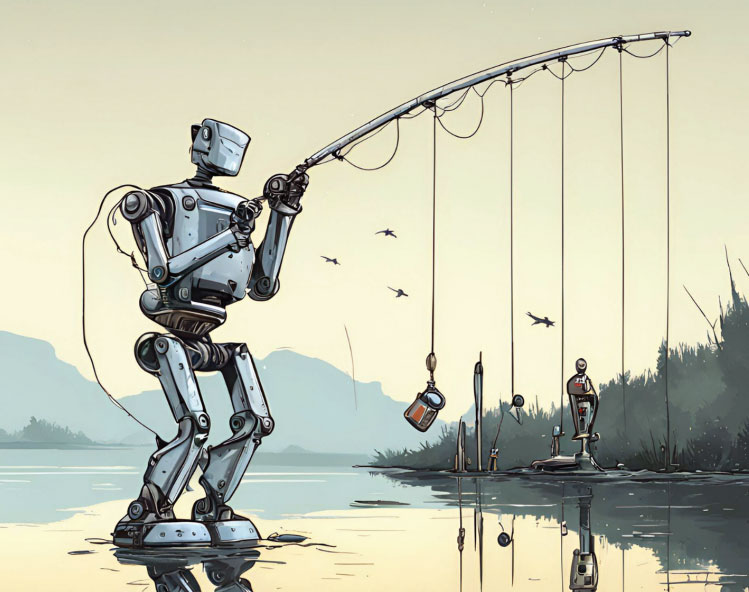Will AI soon be playing a role in a fishery near you? Love it or hate it, as crazy as it sounds the answer is a definite yes, especially if you own a modern fishboat with modern electronics or plan to get one anytime soon. Even in a sport where life can be as simple as threading a worm onto a hook, artificial intelligence is already making inroads. And it might actually help you catch more fish, or at the very least make it easier to drive your boat to them.

Electronic Artificial Intelligence
As things stand, my chartplotter is already a lot smarter than I am. At least, it seems to be confused much less frequently. That may not be saying a lot, but in truth it’s amazingly good at computing stuff without any extra “intelligence” involved. Still, several of the units sitting at the helm of fishing boats are already applying this new wave of I.Q.
Furuno is an early adopter and their new TZtouch XL units capitalize on AI with improved navigational safety, in what they’re calling Risk Visualizer and AI Avoidance Route. Both are calculated in big-brained MFDs, spinning endless ones and zeros around at Ludicrous Speed inside of a hexacore processor. Risk Visualizer provides a 360-degree visual representation of potential collisions while AI is watching (with DRS radar and bathymetric intel) for everything around the boat. That includes moving objects, so it can watch a boat and highlight it as a collision risk if it alters course to cross yours, or deemphasize it as a risk when it turns away. With AI Avoidance Route active, the MFD will incorporate this same intel and decide on the safest route to avoid any detected hazards along your calculated route. Tap a button and an integrated Furuno NavPilot autopilot will drive the boat accordingly. As potential hazards change course, the AI-driven tech has the ability to constantly track it, recalculate, and reconsider. Since this tech has popped up (grown up?) more or less overnight we’re betting it won’t be too long before your fishfinder pulls back the throttles when you run past a big school of fish, or the autopilot turns you towards birds diving far beyond the horizon.

A company called Avikus, meanwhile, has been harnessing AI to develop the NeuBoat system. NeuBoat is designed to handle dock-to-dock route planning and navigation, obstacle detection and collision avoidance via light detection and ranging (LIDAR), as well as automated docking and undocking. You can monitor the boat’s decision-making via a wireless tablet, including 360-degree and birds-eye views of the boat gained via cameras that act as robotic eyes. Futuristic? Youbetcha, but it’s expected to hit the market this year.
AI for the Fishermen, or the Fish?
One area where AI is already having a direct impact on anglers is in fisheries research. As it turns out, computo-brains are really good at interpreting images. And while you or I might gaze at the flanks of a striped bass and see mere stripes, AI sees a fingerprint. The more fish it sees the better it is at differentiating them — and even at predicting how an individual fish’s patterns will evolve as it ages. The U.S. Geological Survey (USGS) Eastern Ecological Science Center has been training it on rainbow trout; the accuracy rate is already up to 90-percent and it’s expected to continue to improve. The first field testing is being implemented this year in a joint project with the USGS, AI builder Wild Me, and Trout Unlimited.
This tech could eventually replace fish tagging. Fish can be “fingerprinted” when young and recognized decades later. The process isn’t invasive, and the tech can be placed right into the hands of anglers like you and me. It’s looking more and more likely that one day, we’ll open an app, take a photo of the fish we just caught, and learn its history at a glance while fisheries scientists learn of its capture.

The Future of AI in Fishing
While these products and projects are already real, there’s plenty more under development as we speak. There are companies training AI to “read” a body of water and judge the hotspots most likely to produce fish at any given time by taking factors like bathymetry, seasonality, weed growth, weather patterns, fish habits, and more into account. You might one day open up your phone’s camera, scan a lake, and with a glance at the screen know where all the best hotspots are likely to be. AI is also being tested by lure manufacturers to design better fishing lures. And it’s being dabbled with in the commercial fishing industry to interpret historical catch data and then suggest where the largest schools of fish might be found today, tomorrow, and the next day.
Will this tech injection into the fishing world be a good thing, or a bad thing? We’re pretty sure that like most tech, it will cut both ways. Some people will appreciate the help, while others will probably want to make their own decisions using natural intelligence (or as we anglers call it: guessing). Either way, many people will opt to get every fish-catching advantage they can… even if they’re still putting a worm on a hook using their own two hands.